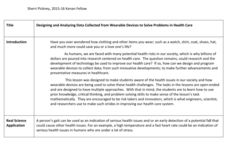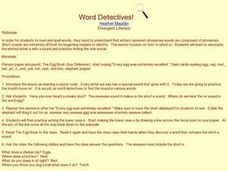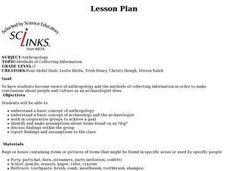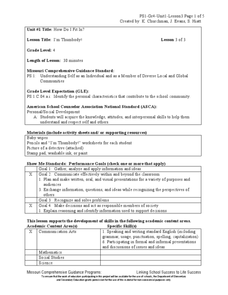Kenan Fellows
Designing and Analyzing Data Collected from Wearable Devices to Solve Problems in Health Care
Wearable devices have become more the norm than the exception. Learners analyze data from a sample device with a regression analysis in a helpful hands-on lesson. Their focus is to determine if there is a connection between temperature...
Curated OER
Are You an Animal Safety Sleuth?
Students identify animal behaviors that are unsafe and react appropriately to the warning signs. In this animal safety lesson, students discuss animal behavior in uncertain situations. Students make flip cards for younger students to...
Curated OER
Word Detectives!
Students recognize the short vowel e in written and spoken language. Through matching activities, students discriminate the short vowel e from the long vowel o. They associate the phoneme with its letter representation and identify the...
Curated OER
Methods of Collecting Information
Third graders examine a bag or box of soil containing items that they dig for. Their task is to become detectives to make conclusions about the area from which the items came as real archaeologists do.
Curated OER
Abra-kadabra-kazam /a//a//a/, POOF!
First graders discover that each letter of the alphabet has a sound then detect the /a/ sound represented by the letter a. They pretend to be magicians and say, "Abra-kadabra-kazam! POOF!" emphasizing the /a/ sound and then repeat an /a/...
Virginia Department of Education
Weather Patterns and Seasonal Changes
Get your class outside to observe their surroundings with a lesson highlighting weather patterns and seasonal changes. First, learners take a weather walk to survey how the weather affects animals, people, plants, and trees during...
Curated OER
Inquiry Lesson
Students explore the poetry of William Blake and the historical context that he presents. A story is analyzed and evaluated in order to solve a puzzle. The political commentary of the poetic piece is examined in this instructional activity.
Curated OER
I'm Thumbody!
Fourth graders write positive statements about themselves. They brainstorm ideas of what a positive thinker looks like and sounds like. Students compare and contrast positive and negative thinking. They complete a worksheet. Students...







